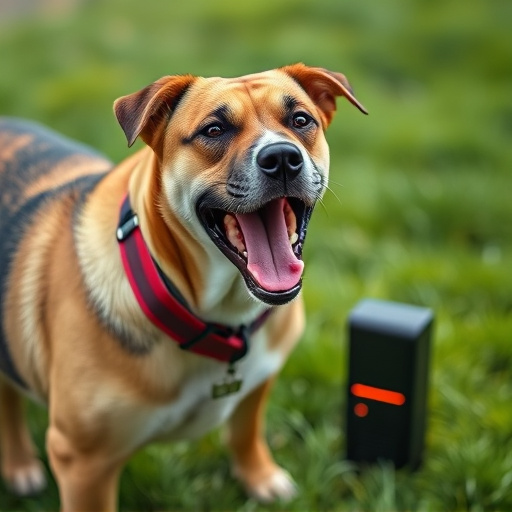Sound wave pet behavior control devices, like dog repellers using ultrasonic frequencies, offer non-invasive, humane behavior modification. Key among these is power consumption, with modern models featuring energy-saving features and long-lasting batteries suitable for both indoor and outdoor use, as confirmed by expert reviews. A comprehensive review of Dog Repeller Device power consumption uncovers insights into device performance and longevity, comparing various models' rechargeable battery runtimes. User feedback highlights the effectiveness of these devices but also concerns about energy usage and cost of frequent battery replacements. For informed decisions, consider energy efficiency, range, and adjustable frequency settings when selecting a dog repeller device.
“Unleash a quieter, more peaceful home with Sound Wave Pet Behavior Control – a revolutionary non-invasive approach to managing pet misbehavior. This technology uses high-frequency sound waves to gently guide and correct your pet’s actions without fear of harm or discomfort.
In this comprehensive review, we demystify how these devices work, focusing on their power consumption. We’ll delve into ‘Dog Repeller Device Power Consumption’ while evaluating user feedback on efficiency and offering key features to consider when choosing the best sound wave pet control device for your furry companion.”
- Understanding Sound Wave Pet Behavior Control: How It Works
- Dog Repeller Device Power Consumption: A Comprehensive Look
- Evaluating Efficiency and User Feedback: What Owners Say
- Key Features to Consider When Choosing a Sound Wave Pet Control Device
Understanding Sound Wave Pet Behavior Control: How It Works
Sound wave pet behavior control is a non-invasive and humane method that utilizes specific sound frequencies to modify animal behavior. At its core, this technology mimics natural sounds that trigger instinctive responses in pets, such as barking or hissing. However, unlike traditional methods that rely on shock or fear, sound wave devices emit high-frequency tones that are generally inaudible to humans but disruptive to animals.
These pet repeller devices operate by leveraging the animal’s hearing sensitivity and their natural aversion to certain sounds. When triggered, they emit a unique sound pattern designed to deter specific behaviors like barking excessively or chasing intruders. For instance, some devices focus on dog repellents, targeting their powerful sense of hearing with ultrasonic frequencies that are safe yet effective. Power consumption is a key consideration, with many modern models incorporating energy-saving features and long-lasting batteries, making them practical for both indoor and outdoor use, as reviewed by experts in the field.
Dog Repeller Device Power Consumption: A Comprehensive Look
Dog Repeller devices, designed to deter canine intruders, have evolved beyond simple noise-making mechanisms. Modern innovations now incorporate advanced technology, including sound wave emission, to control pet behavior effectively. However, one aspect that often concerns prospective buyers is the power consumption of these devices. This review delves into the operational efficiency of Dog Repeller Devices, focusing on their power requirements and how they compare to other similar products in the market.
Powering these repellers are typically rechargeable batteries, with manufacturers claiming varying levels of runtime depending on usage settings. Some models boast extended battery life, making them suitable for large outdoor areas. A thorough analysis of power consumption involves examining both active operation and standby modes. During active use, sound wave emitters demand significant power, often leading to faster battery depletion. Conversely, standby mode, designed to keep the device ready for instant activation, consumes a fraction of the energy. Understanding these power dynamics is crucial in determining the practicality and long-term cost-effectiveness of Dog Repeller Devices.
Evaluating Efficiency and User Feedback: What Owners Say
Evaluating Efficiency and User Feedback: What Owners Say
The effectiveness of sound wave pet behavior control devices is often measured through user feedback and reviews, which provide valuable insights into their performance in real-world scenarios. Many dog owners have shared their experiences with these innovative solutions, highlighting both positive outcomes and areas for improvement. Key metrics in these reviews include the device’s power consumption—an important factor for long-term use—and its overall impact on pet behavior modification.
In terms of user feedback, one consistent theme is the satisfaction levels reported by dog owners. Many praise the devices’ ability to deter unwanted behaviors, such as barking or aggression, without causing harm or stress to their pets. However, some users also mention challenges related to power consumption; they express concerns about frequent battery replacements or charging, which can be cumbersome and costly over time. These reviews underscore the importance of choosing a device with efficient power usage, ensuring it’s a practical and long-lasting solution for pet owners seeking effective behavior control methods.
Key Features to Consider When Choosing a Sound Wave Pet Control Device
When selecting a sound wave pet behavior control device, several key features should be at the top of your list to ensure its effectiveness and suitability for your needs. First and foremost, consider the device’s power consumption. Opting for a model with efficient energy usage not only saves you money on electricity bills but also extends the lifespan of the device. A low-power dog repeller device that still delivers robust performance is an excellent find, as it can operate discreetly without drawing excessive current.
Additionally, review the range and coverage area to guarantee that the sound waves reach where they need to. Different environments demand varying ranges—from small yards to vast open spaces—so choose a device that aligns with your outdoor space dimensions. Moreover, some models offer adjustable frequency settings, which can be crucial in finding the most effective yet humane frequency to deter pets without causing harm or distress.
Sound wave pet behavior control devices have emerged as innovative solutions for managing unwanted pet behaviors. By understanding how these devices work and evaluating their efficiency based on user feedback, owners can make informed choices. When selecting a dog repeller device, consider power consumption, key features, and specific needs to ensure effective and sustainable pet control. A thorough review of these factors will help you choose the best device for your furry companion.
